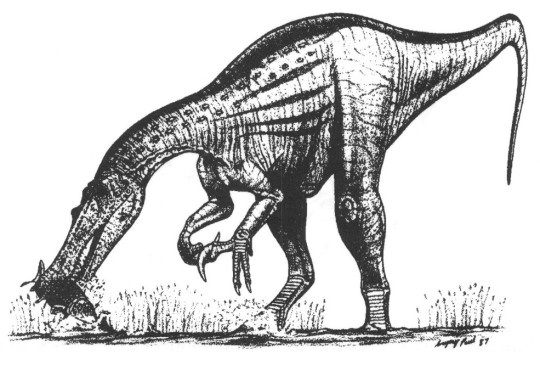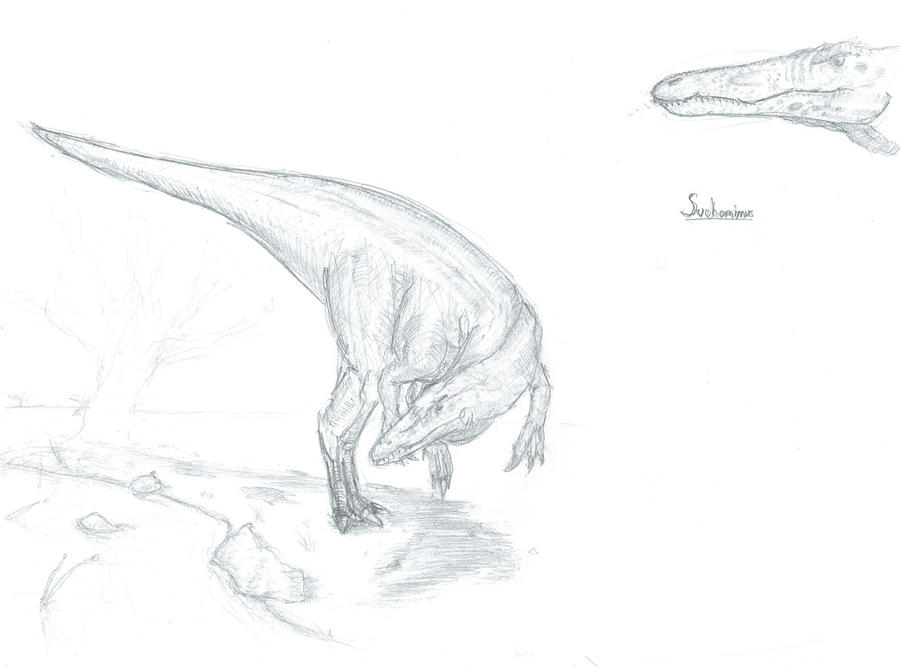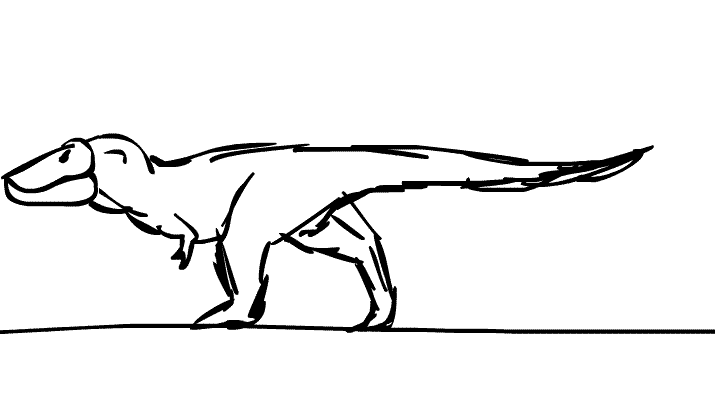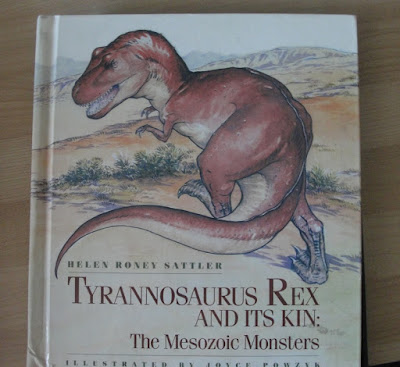Today, dinosaur books are dominated by digital art and, more specifically, CGI. Whether or not this is for the better or worse is certainly up for debate, as
Dorling Kindersley's Dinosaur! encyclopedia has shown that with a little bit of effort and dedication, CG images can work quite well, while
Robert Mash's book How to Keep Dinosaurs has proven the opposite. Regardless on your position, today's books can make it easy to forget that back then, art in dinosaur books was hand-drawn. Forget computers and other fancy 21st Century technology, sometimes all you needed was paint and a canvas. The book in review today,
Tyrannosaurus Rex And Its Kin: The Mesozoic Monsters demonstrates that clearly. On a side note, I feel it's worth noting that the majority of books reviewed on the site will be modern, mostly so it helps reader decide what to buy and what not to buy. Special exceptions will be made, like now, of course, so let's get on to the book itself.
The cover is a gorgeous illustration of the namesake dinosaur. From a time where attention to accuracy was usually not present in paleoart, I applaud Joyce Powzyk for rendering such a fantastic image of the tyrant lizard.
The book starts out with a synopsis of the "Mesozoic monsters," the carnosaurs. Being from 1989, the term carnosaur is used interchangeably with large theropod. Therefore, all dinosaurs referred to in the book are carnosaurs, though in reality only a small fraction can be described as "true" carnosaurs - the allosauroids. In total, a staggering 41 different types of theropods are directly mentioned, and out of those 41, 19 are given illustrations. Some are given more than one (Tyrannosaurus has 5). Keeping in mind the date, as well as the target audience, it's impressive that they included rather obscure dinosaurs like Rapator, Unquillosaurus, and Chingkankousaurus.
Something else that the book does is list the species name along with the genus. Acrocanthosaurus is Acrocanthosaurus atokensis. Dilophosaurus is Dilophosaurus wetherilli. Eustreptospondylus is Eustreptospondylus oxoniensis, and so on. This is definitely something to congratulate the book for, seeing as how very few books will care to put the species name to a dinosaur that is not T. rex.
The text is interesting in that it is very speculative. Constantly, it presents theories and backs it up with fossil evidence. Almost humorously, in the page above it's said that, "Tyrannosaurus could tear huge chunks from its prey-chunks as big as a full-grown goat-and easily swallow them whole." Foreshadowing to Jurassic Park?
I find myself liking Joyce Powzyk's Tyrannosaurus a lot. It's not completely reptilian like previous iterations and has the correct horizontal stance but is old enough to avoid having feathers slapped on. Plus, the red-black color scheme is neat.
Tarbosaurus also makes an appearance. Though the text would say otherwise, the pictures drive home the fact that these are just animals, not some bloodthirsty killing-machine like Indominus rex from Jurassic World.
One of my favorite illustrations in the whole book is this spread of an Albertosaurus. To me, it feels incredibly lifelike; It pictures dinosaurs as highly active creatures by putting the Albertosaurus in a dynamic but believable pose, and being one of the most accurate drawings in the book helps. Beautiful.
Spinosaurus unsurprisingly shows up, inaccurate T. rex head and all. Looking back, I never realized how uncommon it is to have dinosaurs attack crocodiles. In this case the Spinosaurus almost seems more curious than hungry.
Hooray for obscure dinosaur representation! Piatnitzkysaurus gets a full illustration. Those smaller dinosaurs? They're its young, but I thought they were small ornithopod dinosaurs at first.
Ceratosaurs are covered in fairly good detail, and Ceratosaurus himself receives a nice illustration. The Stegosaurus corpse (which you can see partially on the bottom left) is rather odd - the famous kite-shaped plates on its back are replaced mid-way with spikes that look like the thagomizers you would see on the tail. As far as I'm aware, the only other stegosaur that could have coexisted with Ceratosaurus was Kentrosaurus, and there's no sign of a shoulder-spike here.
Another one of my favorite illustrations! The pug-like face of the Megalosaurus is reminiscent of the era, and to see a theropod swim is a real treat. Taking another look at ol' Megalosaurus, the more my mind flashes "abelisaur." Xenotarsosaurus, possibly?
Bottom line, Tyrannosaurus Rex and it's Kin: The Mesozoic Monsters is one of my favorite dinosaur books of all time. Well-written and, perhaps more importantly, well-researched text is crafted with wonderful traditional art that holds up well even nowadays. Outdated as it may seem, the book is well-worth getting solely for the art alone. Being such an old book, a used book store or online is your best option.




































